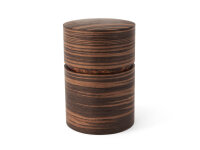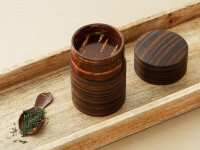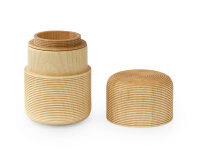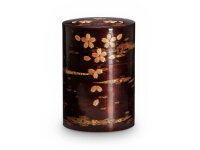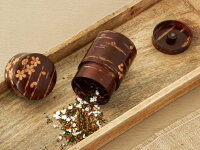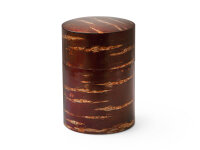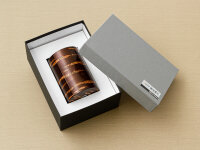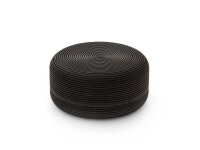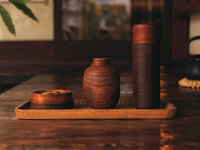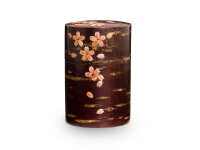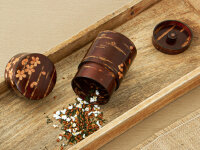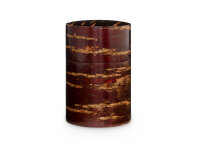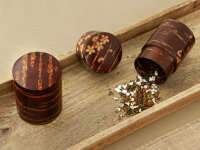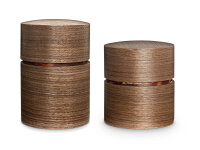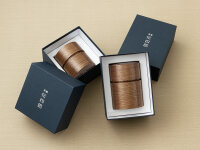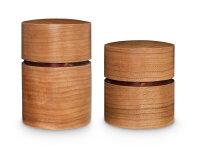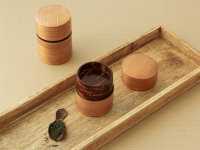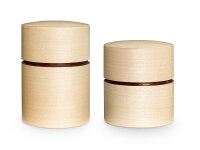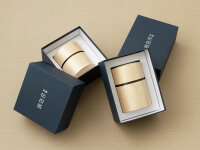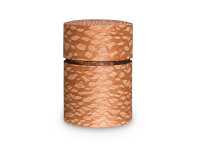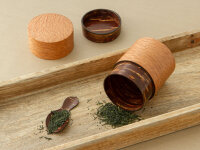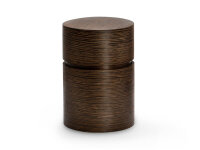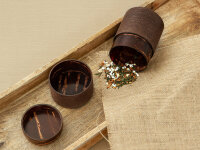
Japanese Tea Caddies
Chazutsu, the Japanese Tea Caddy
The more valuable the tea, the more important the proper storage. In Japan, China, and other tea-producing countries, there is a long tradition of storing tea in tea caddies. Of course, decorative aspects also play a significant role—especially in Japan, where a well-designed tea caddy is highly appreciated. However, the most crucial reason for the tea caddy is likely that the often very high-quality tea deserves equally high regard. Consequently, there is a strong desire to store the tea as well as possible, often in high-quality tea caddies. And "as well as possible" means that the tea must be protected from harmful influences by the tea caddy.
How Sensible Is It to Think About Tea Storage?
Is a tea caddy even ideal? To find the right method of tea storage, it makes sense to briefly consider how the flavor and the many valuable substances in tea can be preserved. And what influences are harmful to the enjoyment of tea and potentially its health benefits. There are not only tea caddies but also several other possible containers.
In particular, ziplock bags or glass containers are alternatives to tea caddies. There are also various types of tea caddies made from different materials such as plastic, metal, and wood. Tea contains many substances that tend to evaporate, including those that are relevant to its aroma and its health effects. High-quality green tea, in particular, deserves good and advantageous storage. Is the tea caddy, bag, or other containers the right place for it?
How Sensitive Is Loose Tea?
Loose tea is nearly devoid of moisture after the drying process. The processing of Japanese green tea is particularly labor-intensive. High-quality teas are characterized by retaining the tea leaves in large pieces. Green tea, as well as all other tea types, is therefore sensitive to breakage. A tea caddy provides protection against this, while a bag offers less.
Another criterion is the temperature at which tea is stored. Around 19°C is considered ideal. Warmer temperatures promote flavor loss. Even the most beautiful tea caddy has no place on a windowsill. It can be a bit cooler, but tea should not be stored in extreme cold, as temperature fluctuations can lead to condensation, even in tea caddies, especially if they are made of metal. Moisture is the third factor that can harm open tea.
The idea of some tea drinkers to store tea in the refrigerator, packaged in a bag or a caddy, has a significant risk. Moisture is a real problem for tea storage, as it can lead to the loss of tea aroma and even the formation of mold, rendering the tea and possibly the tea caddy unusable.
Lastly, there's the issue of light. While the tea plant loves sunlight, the finished tea is a friend of darkness. In summary, tea, whether green tea, white tea, oolong tea, black tea, or other varieties, should be handled carefully due to the risk of breakage and should be stored in a dry, consistently cool environment at around 19°C, sealed, and protected from light to preserve its delicious and healthy qualities for a long time.
Which Materials Are Good, Which Materials Are Critical?
Loose tea is often sold in so-called ziplock bags coated with aluminum on the inside. These bags are generally good protection against light and oxygen, as long as they haven't been opened or are consistently sealed. However, they do not provide ideal protection against breakage if handled frequently or stored in tight spaces.
Solid containers, such as tea caddies, have a clear advantage here. When it comes to protecting tea from moisture, there are better solutions. Once moisture has penetrated a bag, it remains there and is likely to cause damage. Another material used is plastic or film.
For tea caddies made of plastic, we recommend caution. Depending on the type of plastic or film used, there may be reactions with the tea that no tea drinker would want.
Caddies and containers made of metal, aluminum, stainless steel, or porcelain are preferable to plastic. They provide better protection against breakage than bags, but they cannot guard against harmful moisture. Two other highly interesting materials are wood and clay. High-quality tea caddies can be found in both materials. Does a wooden or clay tea caddy really work better?
Wooden or Clay Tea Caddies
Wooden and clay caddies offer a tremendous advantage over caddies made of cold, dense materials: both materials, unless coated, can absorb moisture. The caddy can extract moisture from the surrounding air. Wood, in particular, is capable of this to a greater extent than clay.
This fantastic natural material can absorb more moisture than its own mass. The "hygroscopic" behavior of wood binds moisture from the environment, effectively "regulating" the air climate. The reason for this is the cellular structure and multilayered composition of cell walls. Wood has a porous lightweight structure that allows it to absorb moisture remarkably. Per cubic centimeter, wood has a surface area of 100 square meters. This surface readily absorbs and binds moisture (sorption).
Our clear recommendation: a wooden tea caddy, essentially organic. A wooden tea caddy protects tea from breakage, light, temperature fluctuations, and moisture. Does the wooden tea caddy have any disadvantages?
A Disadvantage That Is Actually an Advantage
At first glance, the price of a wooden tea caddy could be considered relatively high. But let's consider the material of the best tea caddy: wood not only absorbs moisture but also aroma. This results in our recommendation to store the same or similar types of tea in these caddies.
The drawback is that rapid switching between different tea varieties in the same caddy is not ideal and can influence or slightly diminish the tea's flavor. Green tea, with its often subtle flavor nuances, is more sensitive to the slight influence of the tea caddy than a strongly flavored tea.
If a switch is unavoidable, the wooden tea caddy should be thoroughly cleaned - without detergent - thoroughly dried, and left empty and open for some time.
Why is this disadvantage of wooden tea caddies actually an advantage? The caddy's ability to absorb and store aroma can be an advantage for the tea's flavor, especially when adhering to the rule of storing the same or similar tea types in the same wooden tea caddy. The wooden tea caddy retains the aroma, which can actually enhance the tea. Again, this is most beneficial for green tea with delicate flavor nuances.
Tea Caddies from Gato Mikio and Denshiro
Two traditional, small, and fine manufacturers have convinced us for several reasons. The tea caddies from Gato Mikio's Karmi series were one of them. Modern design, traditional high-quality craftsmanship, caddies made from the best natural materials. The wood of Betula Grossa, the decorative cherry birch, is of very high quality and fully utilizes the advantages of wooden tea caddies. But also the construction of the caddies from both manufacturers, with their intelligent double closures, has impressed us and convinced us that we offer wonderful, highly functional products with beautifully crafted tea caddies.
The price of these traditional Chazutsu is not insignificant and is justified by the high-quality craftsmanship, valuable materials, excellent functionality of the caddies, and their outstanding design. For those who prioritize price as the most important factor in their decision, they should consider that these caddies from these manufacturers represent high sustainability and long-lasting durability in relation to the price. You can also find an article on tea storage in our Japan Magazine here.

